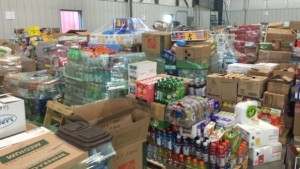The most powerful food safety chat I ever heard was in was June 2006.
 Chapman and I were talking at a U.S. Food and Drug Administration regional meeting in Grand Rapids, Michigan, and Amy tagged along and we went to Canada.
Chapman and I were talking at a U.S. Food and Drug Administration regional meeting in Grand Rapids, Michigan, and Amy tagged along and we went to Canada.
I think.
A few of the FDA folks who had been the first in after Hurricane Katrina in Aug. 2005 in New Orleans had an after-hours pub chat session. The food safety stories were remarkable to hear, the stress still visibly impacting those who had been there.
I’ve heard similar food safety stories and enduring nightmares from first responders in Walkerton, Ontario in 2000, and in Christchurch, N.Z. after the earthquake in 2011.
Mark Cardwell of Canadian Grocer writes that Craig Anderson, Overwaitea Food Group’s general manager of operations for Canada’s three prairie provinces, says Fort McMurray is usually a bustling place with traffic and people coming and going in all directions at any time of day.
But there’s an eerie silence this week as residents begin returning home after last month’s devastating fire.
“Things are unusually quiet,” Anderson said from the Save-On-Foods store at Fort McMurray’s Stoneycreek Village mall just minutes after it officially reopened on Wednesday.
It was the first of the banner’s three locations in the city to reopen.
Only a few other local food stores have also reopened, including Safeway and Walmart locations in the city’s centre.
Anderson said a small but steady trickle of customers had been coming into the store since 8 a.m., when doors opened. They’ve been buying basic food items, cleaning supplies and, especially, water, since a boil-water advisory is still in effect.
“I’ve been to a lot of store openings, but never one like this,” quipped Anderson. “The mood is serious and sombre.”
Before reopening, grocers have to adhere to strict guidelines put out by Alberta Health Services.
Titled “Reopening your food establishment after a wildfire”, the five-page guideline contains a series of steps to deal with the potential damages and risks to people and food from fire, smoke, ash, soot, fire retardant chemicals, water and loss of power.
Food in refrigerators, coolers and freezers, for example, has to be discarded if the temperature exceeded 4 degrees Celsius at any time since May 3, when city residents were forced to flee in what was the largest emergency evacuation in Canadian history.
All exposed food items—from open foods and packaged foods (including paper, cardboard boxes, plastic and cellophane) to single-service items and bottles and jars of food with screw-top lids or crown/crimp caps—also had to be tossed.
